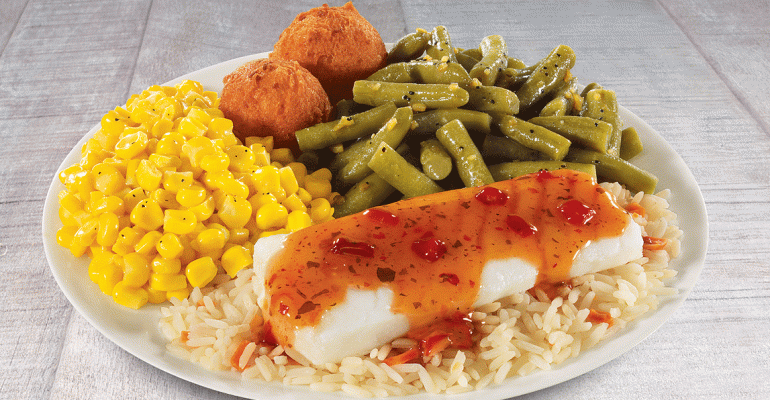Hands down, the biggest menu newsmaker of the past year has been the vegetable, which is taking a well-deserved star turn as chefs work their culinary magic to transform produce of all types into appealing side dishes and entrées. As a corollary, vegetable-based meat substitutes have also grabbed headlines as large chains like Carl’s Jr. and smaller chains like Fatburger have adopted them as burger options.
Yet despite all the excitement around the subject of plant-based cuisine, Americans remain committed carnivores. In fact, the US Department of Agriculture forecast that consumer consumption would reach a record-breaking 222.2 pounds per capita of red meat and poultry in 2018.

Carl's Jr.'s Beyond Meat burger
Trend watchers at The NPD Group note that protein topped the list of dietary interests last year, a demand which combined with moderating meat prices and rising consumer income to make meat on the menu a real opportunity for operators. But successful restaurant marketers have learned that not all meat is created equal, and that many diners, particularly Millennials, want reassurance about their meat choices. Restaurateurs at all levels are stepping up to the challenge, and the widely reported results mark a watershed in chain purchasing strategies.
Better chicken. Major chains like KFC and Burger King have garnered plenty of publicity with their switch to chickens free from antibiotics important to human medicine. Powerhouse sandwich specialist Chick-fil-A has pledged to meet a “no antibiotics ever” policy by the end of 2019, and Wendy’s received broad press coverage with its announcement in 2017 of a $30 million investment to procure chickens that are 20 percent smaller. The initiative aims to provide “more delicious and tender” filets than those of conventional industrial birds and reflects the chain’s commitment to animal well-being.

Wendy's Bacon Maple Chicken Sandwich
Some chains promote a supplier’s brand to reassure patrons, as with Ted’s Montana Grill, which operates 40 stores in 16 states. The operation features Springer Mountain Roasted Chicken, sourced from a Georgia-based company that is certified by the American Humane Association. Waffle House, beloved by road warriors, night owls and post-club partyers, partnered with Springer Mountain in 1986 to upgrade its poultry sandwiches, and well ahead of the pack in 2011, upped the ante by going antibiotic free.
Better beef. Last spring, McDonald’s announced the nationwide rollout of fresh beef in its Quarter Pounders, a move that impacted its system from source to kitchen. The program is meant to improve the chain’s culinary reputation and to make it more competitive with fast-casual better-burger competitors, and analysts who follow the chain pronounced that the sandwiches were noticeably better.
Arby’s, which regularly faces snarky suspicions about its roast beef, is, in fact, a founding member of the Roundtable for Sustainable Beef. Emerging players like Denver’s Urban Farmer Steakhouse and Punch Bowl Social of Austin, Texas, tout their use of the Snake River Farms brand, a Boise-based, family-owned producer dedicated to sustainable meat.
Better seafood. Red Lobster has taken the lead and created a template for marketing sustainable seafood with its long-running commitment to its “Sea Food Differently” and Seafood with Standards programs that play out on the menu in dishes like the wild-caught flounder entrée.
Limited-service seafood chains are also on board. Slapfish, with 15 units based in the Los Angeles area, has parlayed its “Refreshingly Responsible” slogan into what one newspaper called the best seafood restaurant in Orange County. And Long John Silver’s, the 50-year-old granddaddy of fish chains, boasts of charting a new course forward with sustainably harvested seafood like the wild-caught cod that is the centerpiece of the Baked Cod Meal.
Bottom line. There is scarcely a protein category that has not been impacted by changing consumer values and demands. The pasture-raised pork at Chipotle, Papa John’s endorsement of gestation-crate-free hogs or the free-range, grass-fed venison in an Arby’s limited-time offer are items that are totally in tune with the times.
Operators can rest assured that American consumers do not want to step away from their steak knives, but they do want to feel good about the choices that they make. Better meat and seafood provide permission to indulge without guilt and may be harbingers of dietary demands to come.
Nancy Kruse, President of the Kruse Company, is a menu trends analyst based in Atlanta. As one of Linked In’s Top 100 Influencers in the US, she blogs regularly on food-related subjects on the Linked In website.





